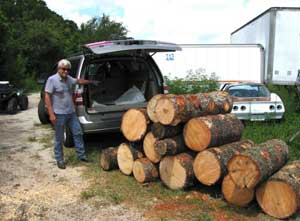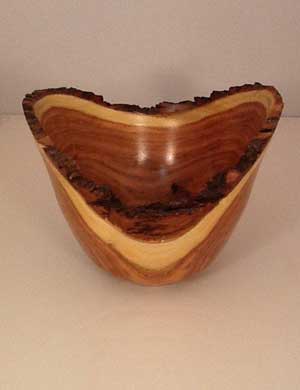
As Bob Collett’s family celebrated holidays like birthdays and Christmas, they would often give his father woodworking tools as gifts. When a gift of a Shopsmith tool included a lathe, “I started messing around and making crude bowls,” Bob said.
That was about 20 years ago. Back then, Bob was involved in buying and selling houses, fixing them up and reselling them. “I had four or five crews, but I didn’t know if they’d show up or not. Idecided to heck with it, and to learn how to take a house apart and put it back together.”
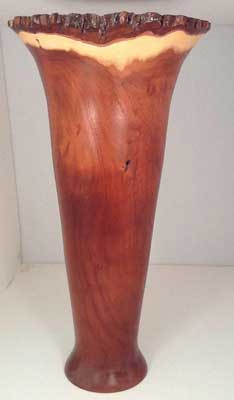
Although Bob still does that sort of thing, these days, his primary interest is in woodturning. “I like to turn large pieces,” like vases, Bob said, although that doesn’t rule out such items as bowls, salt shakers and pepper grinders, and customer requests as well.
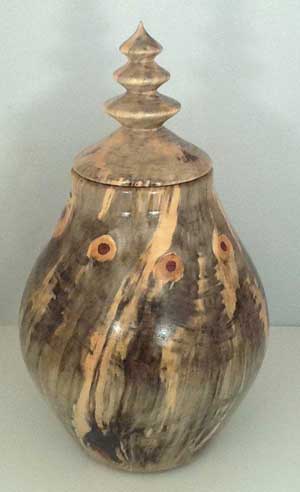
Most recently, he presented his work at a show where “a lady introduced herself as the director of one of the largest funeral homes” in the area and asked if he could make cremation urns. Bob has been doing many of those, as well as urns for pets’ remains. “A lot of people are doing this, to put it up on a shelf and be a memory of Fido — or Grandpa,” Bob said.
Living in Texas, Bob enjoys working with mesquite, which is plentiful in the area. “It has a distinctive sap line, that’s not exactly yellow, and the inside is not exactly amber — it’s more of a dark brown-red. The combination of the two is what makes the pieces interesting.”
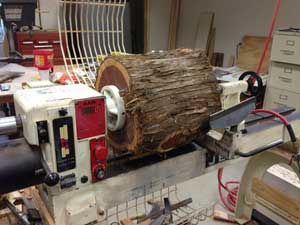
The thing Bob likes about turning, he said, is “all kinds of interesting characteristics about the wood, just the basic beauty of the wood.” Each piece he does is different, with no duplicates: “As I go into a piece of wood I’m working on, whether it’s a 300-lb. log or a piece for a small Christmas ornament, as I get deeper and deeper into the wood, it’s exciting.
“I’ll have the piece on the lathe and leave the bark on right around the edge of the piece — that creates a lot of interest — and the wood will tell me what to do further at that particular point. It’s kind of like opening a rock geode and finding the beauty inside.”
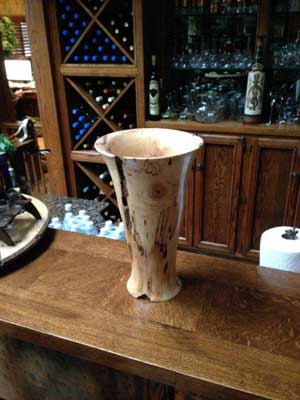
In addition to mesquite, Bob likes to work with Norfolk Island pine. “One of its characteristics is that’s a straight up and down tree, and the limbs are all on the same plane. If you get into a piece of wood under the bark, you can see the limbs and how they’re uniform. If you come into it in different ways, you get a different effect.”
He also likes Osage orange’s brilliant yellow color: “It’s hard as steel, but when you get through with it, it is spectacular.”
While he does order some woods, like ash and maple, from a northern sawmill, most of Bob’s wood is “found” or “curb” wood. “We get a lot of tornadoes and storms, and I’ve got the chainsaws in the back of the pickup and I’m out there getting wood people have left on the curb. I never know what I’m going to find until I get a big old log on the lathe, and get the bark off and start seeing the grain and how it flows and that.”
Sometimes, Bob will find a large crack in the wood, whether due to insect damage or the structure of the piece. “I’ll the cracks or voids I find and dig ’em out and inlay ’em,” Bob said. “I like to use turquoise: it has a great effect, particularly on darker wood.”
For finishing, he prefers a natural wood look, with many of his pieces getting 10 or 12 coats of lacquer, followed by a coat of hard wax for protection.
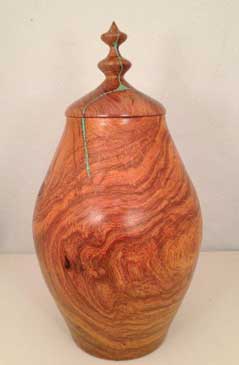
While Bob says, “Not all wood is pretty — sometimes it makes nice firewood,” his basic philosophy is, “I like to emphasize the basic quality of the wood: the beautiful grain and color and figure and burl pattern.”
